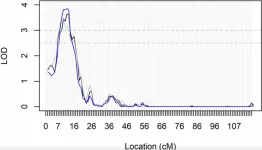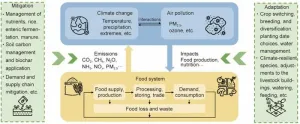Study offers insights into evolutionary process driving pancreatic cancer
Read summary | Read study in Nature
Pancreatic cancer is hard to treat because of its heterogeneity, a characteristic frequently sustained by the ability of cells to change states. One example is epithelial-to-mesenchymal transition (EMT), in which epithelial cells become more mobile. While EMT plays a critical role in many cellular processes, cancer cells have leveraged EMT to promote treatment resistance and metastasis. To better understand its functional role in cancer progression and evolution, Luigi Perelli, M.D., Ph.D., Giannicola Genovese, M.D., Ph.D., and collaborators established genetically engineered lab models that allowed them to examine tumors derived directly from cell lineages undergoing EMT. They discovered that EMT is a necessary step for epithelial tumors to become malignant. Tumors with mesenchymal features also have increased chromatin accessibility and genomic instability – particularly through the breaking and rearrangement of chromosomal pieces – leading to increased heterogeneity within the tumor, which is favored by EMT across lineages. These findings support the concept of restricted patterns of evolution within specific cell states, providing valuable insights into how tumors acquire heterogeneity and strategies to target pancreatic cell progression.
Surgery enhances immunotherapy in advanced kidney cancer
Read summary | Read study in Nature Communications
Patients with advanced solid tumors are usually ineligible for surgery. However, surgically removing the primary tumor in preclinical models of metastatic disease helped to overcome immunosuppression, suggesting that surgical resection may enhance antitumor response in patients receiving immune checkpoint therapy. In a prospective pilot trial from the James P. Allison Institute™, researchers led by Padmanee Sharma, M.D., Ph.D., Sangeeta Goswami, M.D., Ph.D., Jianjun Gao, M.D., Ph.D., and Sreyashi Basu, Ph.D., evaluated the safety and efficacy of combining immune checkpoint therapy with cytoreductive surgery or biopsy in 104 patients with clear cell renal cell carcinoma. The median overall survival was 54.7 months for patients receiving immunotherapy plus surgery. Additionally, surgery increased the amount of antigens that could be recognized by T cells and reduced immunosuppressive myeloid cells. These findings suggest that combining surgery with immune checkpoint therapy in a metastatic setting potentially enhances the antitumor response.
Researchers identify epigenetic biomarker for breast cancer metastatic relapse
Read summary | Read study in Nature Communications
Cancer cells that initiate metastasis at secondary sites often enter a dormant state, allowing them to evade treatment and later reawaken to form macroscopic lesions. To clarify the role of epigenetic pathways in this process, Jayanta Mondal, Ph.D., Jason Huse, M.D., Ph.D., and colleagues used an in vivo epigenetic screen on models of breast cancer metastatic dormancy and recurrence. In this study, they identified Brd7 – which is involved in chromatin remodeling – as a critical epigenetic mediator of breast cancer dormancy in the lungs. Brd7 loss caused metastatic reawakening and created a tumor-promoting immune microenvironment – including neutrophils, CD8+ exhausted T cells and CD4+ stress response T cells – that promotes growth of lung metastases. Depleting neutrophils in vivo reversed these effects, highlighting potential therapeutic strategies to target the growth of metastases in the lungs. These findings also suggest specific epigenetic proteins, such as Brd7, can be used as prognostic biomarkers to predict metastatic relapse.
Bioinformatics chatbot can analyze large-scale cancer proteomics data
Read summary | Read study in Nature Communications
Comprehensive cancer omics initiatives like The Cancer Genome Atlas (TCGA) provide a wealth of DNA and RNA data, but little is known about the resulting proteins. Researchers led by Han Liang, Ph.D., previously created a protein atlas of almost all cancer hallmark pathways and targets. However, this tool provided limited coverage of proteins and had little flexibility for user inputs. To address this, they streamlined the analysis process for end users, creating an intuitive bioinformatics chatbot powered by large language models – DrBioRight 2.0. This highly customizable platform uses natural language to explore and analyze large-scale proteomics data, highlighting its potential to accelerate research and improve accessibility to advanced bioinformatics tools.
Combination therapy yields strong long-term overall response rate in newly diagnosed acute myeloid leukemia patients
Read summary | Read study in Leukemia
Intensive chemotherapy remains the standard treatment option for medically fit patients with newly diagnosed acute myeloid leukemia (AML). However, many patients face relapse. In a Phase II trial led by Courtney DiNardo, M.D., patients with newly diagnosed and relapsed/refractory AML were treated with a novel combination of fludarabine, cytarabine, granulocyte colony-stimulating factor, and idarubicin (FLAG-IDA) combined with venetoclax. The overall response rate was 97% in newly diagnosed patients, with 95% achieving undetectable measurable residual disease status. Importantly, complete remission and three-year overall survival rates were similar across all AML risk categories, suggesting a particular benefit for select patients with high-risk disease. In relapsed/refractory patients, the highest benefit was seen when the combination was used early. Patients who had only one prior treatment and wildtype TP53 had an overall response rate of 79%, and 57% of these patients were able to transition to stem cell transplantation, the only potential curative consolidative treatment in relapsed/refractory AML.
Phase II study identifies potential biomarkers in HPV-positive anal cancer
Read summary | Read study in Clinical Cancer Research
Cytotoxic chemotherapy is the standard of care for patients with unresectable and metastatic squamous cell carcinoma of the anal canal – a rare type of anal cancer often linked to human papillomavirus (HPV) infection. However, this treatment has limited efficacy, and patients have a poor prognosis. To address this, researchers led by Van Morris, M.D., conducted a Phase II trial to evaluate the combination of the anti-PD-L1 antibody atezolizumab and anti-VEGF antibody bevacizumab in 20 patients with unresectable and/or metastatic HPV-associated anal cancer. They also collected tissue biopsies from each participant before and after treatment to further analyze tumor-immune microenvironments. While the combination therapy was not superior to standard treatment, the biopsies identified chromosomal and transcriptomic markers that were linked to longer survival in patients treated with immunotherapy. The study provides critical insights into the tumor-immune microenvironment and identifies potential new biomarkers that could improve future treatment studies.
- 30 -
END




